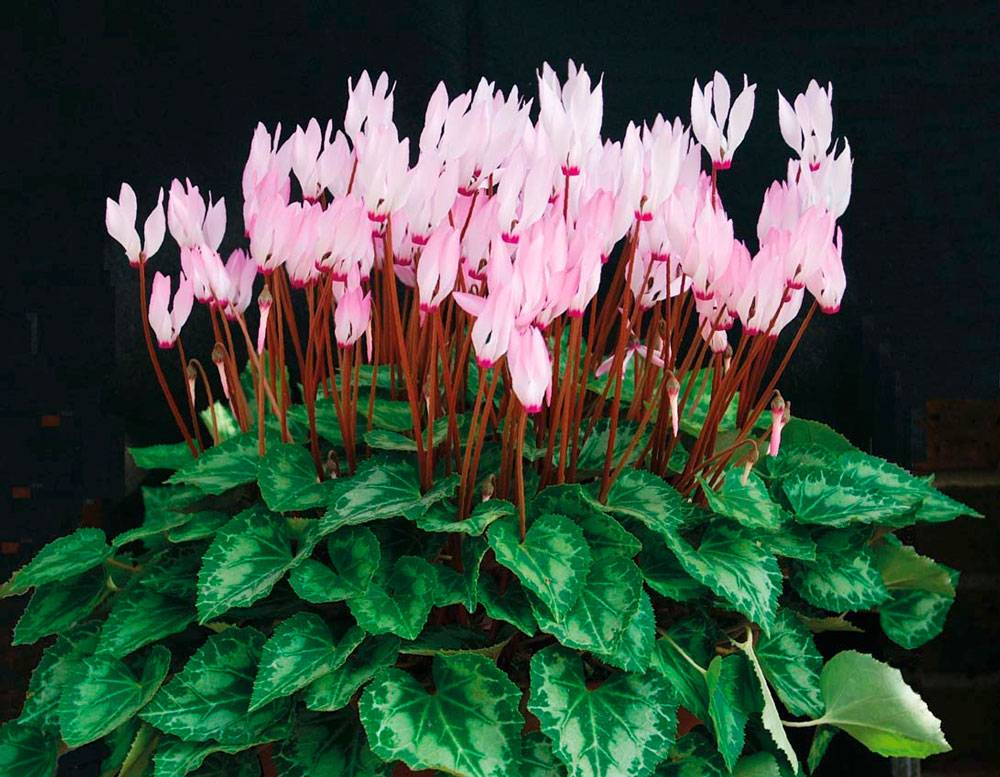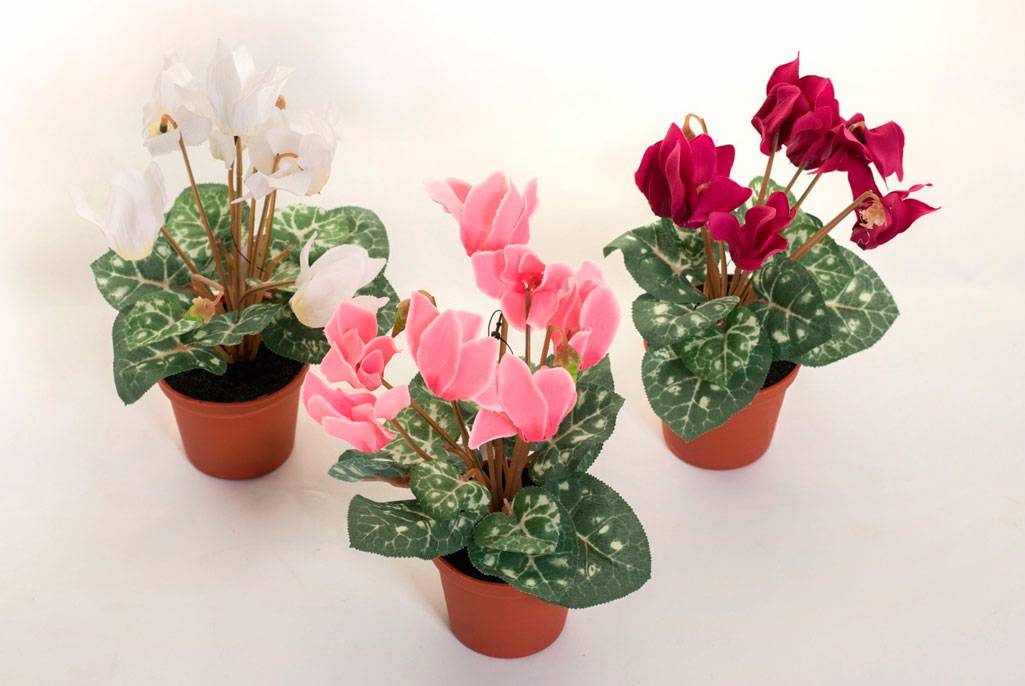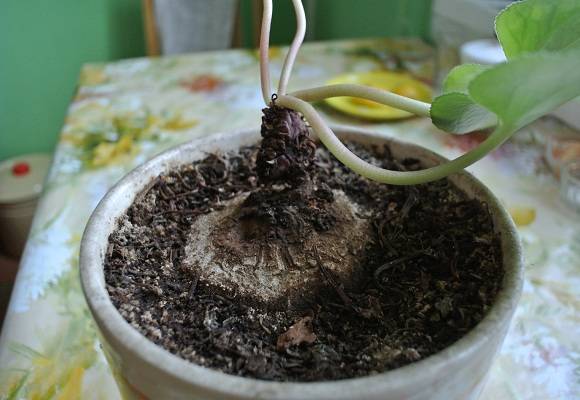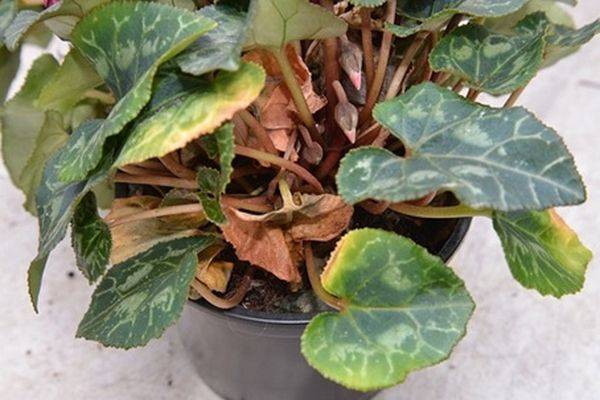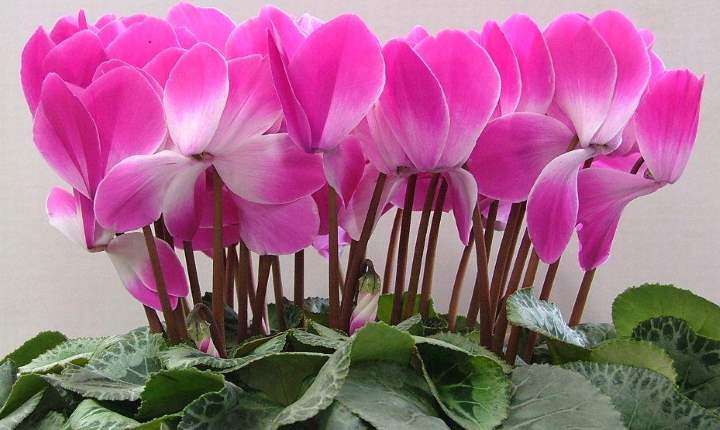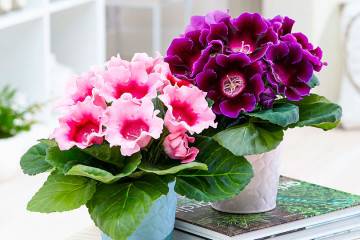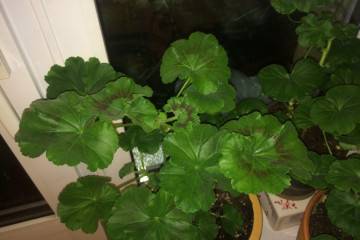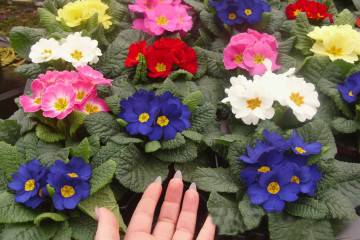Why cyclamen does not bloom: the main reasons and methods of resuscitation
Content:
Cyclamen is an alpine violet that can decorate any interior. Which country is the birthplace of the flower is unknown. There is an opinion that the decorative culture came to Russia from Central Europe. This amazing flower is naturally endowed with a delicate aroma. Flowers rise spectacularly above the leaf blades. There are many varieties of cyclamen, which differ in height, color and shape of the inflorescences. However, the alpine violet does not always please its owner with a gorgeous flowering. Below you can familiarize yourself with the reasons why flowering does not occur and how to eliminate them. If you follow the recommendations of experts, it will be quite easy to care for the culture.
Why cyclamen does not bloom at home
Often, the plant not only does not want to bloom, but also looks quite painful. Why does cyclamen not bloom, but only leaves grow? The main reasons against which the formation of buds is impossible are described below.
Root system at great depth
When planting a seedling purchased in a specialized store or in a nursery, you should carefully consider the depth of planting of the root system. Ornamental crop tubers should rise by a third above the soil surface. Deeper planting will negatively affect the health of the plant. In this case, flowering will not occur.
Temperature violation
Cyclamen prefers a cool climate. Flower containers should be placed in a room with a temperature between 16-17 ° C.
In the summer, when the plant is in the dormant stage, you should create the most comfortable conditions in the room.
In cases where the indoor temperature exceeds 19 ° C, buds stop forming and flowering does not occur. Gradually, the leaves of the cyclamen curl.
Excessive watering
If you follow the recommendations of specialists regarding the care of flowers, the process of growing plants will not cause unnecessary trouble. Improper watering can also be the reason for the lack of flowering.
Ornamental culture does not need frequent moistening of the soil. An excess of moisture will negatively affect the appearance of the alpine violet. The plant will start to get sick systematically, the leaf plates will turn yellow, the root system will start to rot, and the owner of the crop will never see the flowers.
During the formation of buds and blooming of buds, experienced flower growers recommend moistening the soil 1 time in 8-9 days. If, after a specified period of time, the topsoil remains wet, it is worth postponing watering for a couple of days.
Diseases and pests
When growing cyclamen, it is important to systematically inspect the bushes to make sure that there are no ailments and pests. If diseases and harmful insects are detected, measures should be taken to eliminate them as soon as possible. Otherwise, flowering will not occur, and the alpine violet may even die.
Improper flower care can provoke the development of such ailments as:
- fusarium;
- gray rot;
- wet rot;
- fungal and viral infection.
It is worth talking about diseases and pests in more detail.
Diseases of cyclamen
Below you can find the most common diseases that alpine violet is susceptible to and how to treat them.
Yellowed leaves
Yellowing of the leaf plates often appears against the background of pest damage or lack of sunlight in the summer. In addition, the problem occurs when the level of humidity is low.
Containers with flowers in the autumn period must be placed on the windows on the east side. In the cold season, it is better to transfer flowers to the southern windows. Lighting should be bright and diffused.
If necessary, you can arrange artificial lighting for a decorative culture. For this purpose, you can use a fluorescent lamp.
During home care for cyclamen, the leaves turn yellow, wither, what can it be? Yellowing and lethargy of the leaf plates can occur in stuffy rooms with poor air circulation. The presence of carbon monoxide and tobacco smoke in a room negatively affects the health of flowers.
Often, novice lovers of indoor plants ask: the leaves of cyclamen turn yellow, what should I do? The room in which the pots are located should be regularly ventilated. The room temperature should be between 16-18 degrees.
Wet rot
Dangling of flowers and leaf plates, the presence of a sharp, unpleasant odor indicates the occurrence of wet rot.
The root system gradually decays. This process can develop against the background of a crack or wound on the vegetative organ or tuber, bacteria entering the flowers.
The main source of infection is considered to be contaminated water, which the grower uses for irrigation. Affected bushes are destroyed to avoid contamination of other flowers.
Gray mold
Improper care of the alpine violet can provoke the appearance of gray mold, which is evidenced by a silvery coating on the leaf plates. The cause of the onset of the disease is a fungus that occurs due to prolonged dampness in the room.
Affected flowers are distinguished by the presence of:
- a silvery shade on sheet plates;
- affected peduncles;
- darkened and falling buds or flowers;
- drying sticky foliage affected by the fungus.
To cope with the disease, it is recommended to remove the rotted areas of the alpine violet with a sharp knife. Flowers need to be treated with fungicidal agents. You can also treat the plant with folk methods.
Root rot
Fusarium is a fungal disease caused by the fungus Fizarium. Florists call the disease Fusarium wilt or dry rot. The fungus that penetrates the green space begins to release toxic substances, which leads to wilting and death of flowers. Root rot pathogens are often found in the soil mixture and enter the plant through its roots.
Affected flowers are distinguished by the presence of:
- yellowed upper part of the leaf plates;
- painful appearance of decorative culture;
- rotted bundles of blood vessels that can be seen when cutting the tubers of the alpine violet.
The leaves of the cyclamen turned yellow, and the roots began to rot, what should I do? To save the flowers affected by the disease, experts recommend spraying the plantings with 0.1% Topsin-M. When watering, use a foundation solution.
Anthracnose
Why do cyclamen leaves curl? Often the reason for this is anthracnose. The disease can occur against the background of infection of flowers with a fungus that belongs to the genus Gloeosporium. The fungus has a particularly negative effect on the plant during the period of bud formation. The fungus spreads quickly in cases of high humidity in the room in which there are flower pots.
The main symptoms of anthracnose include:
- impossibility of full development of peduncles;
- distortion of the appearance of the plant;
- infection of leaf plates, against the background of which they curl and crumble.
To avoid the occurrence of anthracnose, you should pour steamed soil into the pots during planting. Already infected bushes are treated with fungicidal agents several times.
Potential pests
Harmful insects can also harm cyclamen. Below are the main pests that threaten the alpine violet.
Aphid
Aphids suck nutritious juice from green spaces. With a massive invasion of pests, leaf plates and inflorescences begin to deform.
Aphids can be colored in different shades:
- grey;
- green;
- Orange;
- the black.
The appearance of a dandruff-like plaque indicates that the plant is affected by aphids. To deal with harmful insects, it is recommended to spray green spaces with insecticidal products. Pre-rinse the alpine violet leaf plates under running water.
Cyclamen pliers
Pests are colored yellow. Cyclamen ticks have 4 legs. Their activity is aimed at affecting the inner surface of the leaf plates. Seeming dust on flowers is a place of mass accumulation of mites. The extreme parts of the foliage gradually change shape.
Finding out why the leaves of the cyclamen curl, it is worth checking it for pests. With their massive accumulation, the buds fall off, and the stems are strongly twisted.
To cope with the invasion of insects, you should start removing the affected flowers and buds. Plants need immediate treatment with insecticidal or folk remedies.
How to revive flowers
How to make an indoor flower bloom? First of all, it is important to understand what could be the reason for the lack of flowers in a decorative culture. The first step is to try to rearrange the pot to a different place that suits him better. After that, it is necessary to inspect the sheet plates and soil.
In case of detection of diseases or pests, spraying of alpine violets with special means should be carried out immediately.
Further home care
Cyclamen has faded, what to do next at home? Caring for cyclamen after flowering is quite simple. The activity and regularity of flowering depends on how the cyclamen spent the rest period. Therefore, it is important to properly care for the ornamental crop throughout the year.
The recommendations of specialists regarding the care of an alpine violet are presented below.
- The temperature in the room in which the flowers are located should be between 16-18 degrees.
- Flower containers are placed in areas with diffused light.
- The recommended frequency of soil moistening is once every 9-10 days. However, it is necessary to look behind the top layer of the soil. When it dries completely, the plant should be watered immediately, regardless of the schedule of the moisturizing procedure.
- When inspecting green spaces on a daily basis, it is recommended to pay attention to the appearance of leaf blades and stems. The presence of cracks that can lead to decay and death is unacceptable.
- After the end of the hibernation period, alpine violets need to be transplanted into a new nutrient substrate. In this case, it is important to control that the tuber rises by a third above the soil surface.
- Before the flowering period, it is important to spray the leaf blades and air near the flowers several times a week.
Fertilizing cyclamen is necessary for the formation of a large number of buds. Every 2 weeks, complex fertilizing is introduced into the soil mixture. During the flowering period, the culture does not need feeding.
With any transplants, the soil should be steamed and treated with a solution of potassium permanganate, which will reduce the susceptibility of plants to a number of diseases. For planting, it is better to use a self-prepared substrate consisting of nutritious soil, perlite and sand. In addition, it is advisable to add sheet soil to the soil mixture. You can feed the plant with any complex fertilizers.
Cyclamen after flowering in a pot, what to do with it? The culture needs to be watered only once every 30 days and the leaf plates must be inspected daily for the presence of diseases or pests.
Growing cyclamen at home is quite simple and interesting. You can even grow your own crop using the seed. However, in order for the plant to please with lush flowering, it is important to adhere to the recommendations of specialists regarding the care of an ornamental crop.
